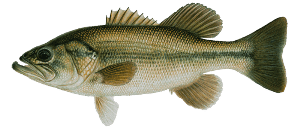Characteristics

Although this species likes rough water it prefers clear water with sandy beds and plentiful weeds. They also prefer warmer water up to 80 degrees. Some have been know to survive in higher temperatures.
Largemouth feed on other small fish like, minnows, crayfish, and insects like dragonflies as well as other types of small creatures that fall into the water.
Since they feed mostly by sight, they do have the ability to feel vibration through a lateral line along their body, which is a sense organ. Movement will trigger the organ allowing the Largemouth Bass to pick-up on the vibrations. The fact that these fish have this ability makes catching Largemouth more successful when lures and baits that create motion are used.
Habitat
The Largemouth Bass lives in inland lakes and streams that have firm sand, mud or gavel. Most live in water that is 2-6 feet deep. The characteristics of these lakes and streams make spawning successful. When the water temperature reaches approximately 60 degrees, usually during late April early June, the bass move from deep water towards more shallow water. The bass will fan out a shallow dish shape nest with its tail. When the water starts to get warmer the female bass will lay approximately 2,000 – 7,000 eggs depending on how much the female bass weighs. The female will leave the spawning area and move into deeper water.
The male will guard the nest until the eggs hatch and become mature enough. The male guards its nest to protect their offspring from predators. During this time the male bass will not eat. It will attack anything that gets close to the nest, including lures. The male will not eat it’s catch. It will move it’s catch away from the nest and discard it. Later once the small fish have left their nest, the Largemouth will eat it’s catch.
Because the male protects the nest, most of the offspring survive allowing the Largemouth Bass to populate quickly. The weather plays an important factor in the male protecting the nest. If the weather becomes too cold too rapid, the male will leave the nest reducing the number of eggs that will hatch due to being eaten by predators.
As the water gets warmer the Largemouth will spend a majority of their time in thick cover or deeper water. They do move into shallow water to feed usually during the evening and early morning.
Largemouth are very adaptable and reproduce often. Because they reproduce very well, a few bass can increase the Largemouth population. This is why it is very important to protect this fishes habitat.
The DNR is always working on the protection of fish habitat and maintaining a good balance of fish and lake environment in an effort to keep fish well for anglers.
Equipment
Anglers use either bait casting or spinning reels when fishing for this type of species. It is recommended that you use a medium action rod and 8-10 pound test line. Spinner baits and crank baits are good to use to catch this type of fish. Since Largemouth Bass tend to gravitate toward heavy weeded and lily pad areas, it is recommended that you also use weedless surface baits as well.
Tips for Fishing
If you look for weeded areas with lily pads you’re sure to find a Largemouth Bass hiding underneath.

